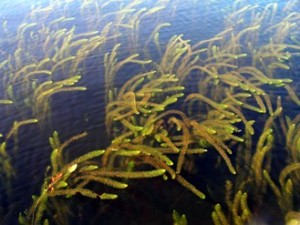Maine Milfoil Summit Examines Sustainability of Programs
McCurdy Pond, Bremen, Maine: A Slice of New England-style Americana
March 1, 2012Pemaquid Lake, Nobleboro and Bremen, Maine: Listen to the Laughter of the Loons
March 4, 2012Maine Milfoil Summit Examines Sustainability of Programs
Milfoil in the Songo River, Naples, Maine
Sustainability was the theme of the 13th Annual Milfoil Summit held at the Lewiston/Auburn Campus of the University of Southern Maine. Peter Lowell, executive director of the Lakes Environmental Association (LEA), commented that it’s time to look at what we can do to keep the ball rolling in the prevention of and fight against invasive aquatics.
The summit began with a fifteen minute video entitled “Facing the Tipping Point: The Future of Maine’s Invasive Species Program,” created by Roberta Scruggs of LEA. In the video, Jackie Bailey of the Maine Milfoil Initiative pointed out that about ten years ago only ten lakes in Maine had aquatic invasives, but now 23 lake systems are dealing with the problem. That being said, Maine is better off than New Hampshire with 76 infested lakes, Vermont with 100 infested lakes and Massachusetts with 900 infested lakes.
As John McPhedron, biologist with Maine DEP stated, there is still energy in the state to reduce the impact of the plants. Funding, however, is a key part of sustainability of any program. He noted that there is a public misconception that the Milfoil Sticker Fee pays for all of the work, when in fact it only pays for a small portion. Local towns and lake associations must write grants and hold fundraisers to acquire the full funds necessary to combat the invasives. And volunteer hours are needed–countless volunteer hours.
David Sanderson of Lake Arrowhead Association said that prevention, rapid response, and sustainment are the key factors necessary to address the invasive plant issue. “If it’s in the watershed, it’s coming your way,” he warned.
Patricia “Patty” Aho, the DEP commissioner, addressed the group, reminding them that Maine has been the leader on this issue for a number of years. She said her department sees prevention, early detection and plant control as priorities. Ms. Aho stated that the Courtesy Boat Inspector (CBI) Program is the most effective prevention tool. The DEP contracts with LEA and the Congress of Lake Associations (COLA) to train volunteers and organize inspection programs. Last year, 76,000 boats on 196 lakes were inspected, which was 3,000 more than the previous year. Of those, there were 287 saves from spreading invasives into more waterways.
The Maine DEP has declared this year as The Year of Self Inspection. All boaters are encouraged to make this the year they inspect their boats and equipment before entering and after leaving a waterbody. Currently, CBIs report that only about 20% do this. Self Inspection of boats is the most effective and most cost effective approach. Even canoeists and kayakers should check their boats and paddles for plants.
Following the commissioner’s comments, key people from various agencies spoke about their programs. Peter Lowell mentioned that funding is the limiting factor when it comes to prevention, especially as there are no more federal earmarks. He mentioned several options including passive watercraft sticker sales, (currently only motorboats and seaplanes must pay for stickers–$10/in state resident, $20/out of state). For the short term, sustainability means keeping volunteers working and continuing to network with the DEP and other groups.
A representative from Save Sebago Cove explained that several lakefront property owners invested their own monies to create a map of the infestation in their section of Sebago Lake. Once the map was completed and they could show people where the problem areas were, one hundred people signed on to support an eradication program. Today, people “Pay to Play” by paying for a given number of hours to keep the suction harvester working.
Roberta Hill of the Volunteer Lake Monitoring Program pointed out that there are currently 2,800 people trained statewide to perform Invasive Plant Patrols. They are able to detect something suspicious and know what to do with it.
During a Q & A period at the end of the summit, it was noted that the next generation needs to be involved in the sustainability picture. Programs such as Vital Signs promoted by the Gulf of Maine Research Institute, which encourage citizen scientists of all ages, are imperative to continue in the eradication of invasive species.
If you have any ideas on sustainability of these programs, you are encouraged to e-mail your comments to Peter Lowell at lakes@leamaine.org.

